Are you looking to become a feline magnet and attract cats into your life? Understanding cat behavior and providing the right environment is the key to attracting these furry friends. From cat toys to catnip, there are simple techniques that can make your space irresistible to cats.
Key Takeaways:
- Training cats is possible and provides mental and physical stimulation.
- Cats are motivated by rewards, so positive reinforcement is crucial.
- Teach your cat basic commands like sit, come, and target for better communication.
- Positive reinforcement training strengthens your bond with your cat.
- Training is important to prevent boredom, frustration, and destructive behavior.
Training Cats: Understanding Their Behavior
When it comes to training cats, understanding their behavior is key. Cats have their own unique personalities and motivations, and training should be tailored to their individual needs. It’s important to remember that cats are independent creatures, much like teenagers, and they respond best to positive attention, playtime, and food rewards.
Training cats should focus on behaviors that come naturally to them. Clicker training, for example, can be an effective method. This involves assigning words or cues to the cat’s natural behaviors and rewarding them for cooperating. By associating the desired behaviors with positive reinforcement, cats can learn to repeat these behaviors on command.
Building a good relationship with your cat is fundamental to successful training. Spend quality time with them, engaging in interactive play and providing mental stimulation. Cats are more likely to respond positively to training when they feel a strong bond with their human companion. Remember, training is not about dominating the cat, but rather fostering a cooperative and loving relationship.
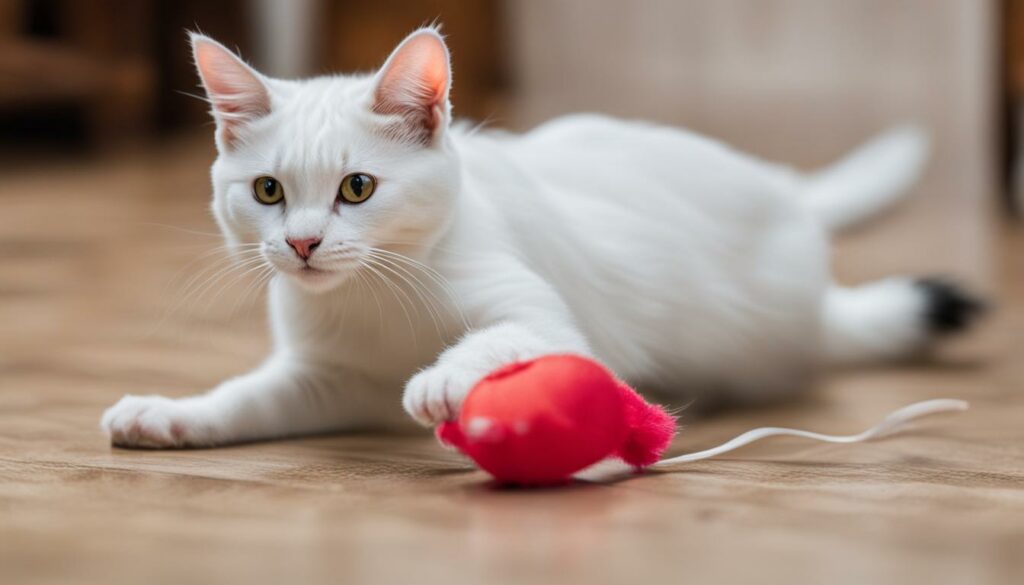
Training Cats: Teenage-like Behavior
Just like teenagers, cats can exhibit behaviors that might be considered challenging. They may test boundaries, become aloof, or engage in mischief. This is completely normal and can be attributed to their independent nature. Understanding these teenage-like behaviors can help you approach training with patience and empathy.
“Training cats requires a balance of guidance and respect for their individuality. It’s important to provide structure and clear expectations, while also allowing them the freedom to express their natural instincts and behaviors.”
By acknowledging and respecting your cat’s unique personality and teenage-like tendencies, you can build a stronger relationship and achieve better training results. Remember, training is an ongoing process that requires consistency, positive reinforcement, and a deep understanding of your cat’s behavior.
| Common Teenage-like Behaviors | Training Approach |
|---|---|
| Testing boundaries | Set clear rules and boundaries, reward positive behaviors |
| Aloofness or independence | Provide positive attention and engage in interactive play |
| Mischief or destructive behavior | Redirect their energy toward appropriate toys and activities |
Teach Your Cat These 7 Words and Actions
Training your cat to understand and respond to basic commands can be a fun and rewarding experience. By teaching your feline friend these seven words and actions, you can enhance their behavior and strengthen your bond. Remember, training sessions should be short and end on a positive note, so your cat stays engaged and motivated.
Gentle
Teaching your cat to be gentle is essential for managing their behavior around children or other animals. Start by gently stroking their fur and saying the word “gentle” in a calm tone. If your cat becomes too rough, immediately withdraw your hand and say “no.” Repeat this process until they understand that being gentle leads to more positive interactions.
Find It
The “find it” command is a great way to stimulate your cat’s natural hunting instincts and provide mental exercise. Start by hiding a treat or favorite toy in plain sight and saying “find it” as you place it. Encourage your cat to locate and retrieve the hidden item. Gradually increase the difficulty by hiding it in more challenging spots.
Target
Teaching your cat to target an object with their nose or paw can help redirect their behaviors and keep them focused. Use a small stick or target wand, and present it to your cat. When they touch the target with their nose or paw, reward them with a treat or clicker sound. Practice this command regularly to strengthen their response.
Sit
The “sit” command is a fundamental behavior for cats and can be taught using treats or a clicker. Hold a treat above your cat’s head, and slowly move it backward. As your cat follows the treat with their eyes and sits down, reward them with the treat and praise. Repeat this process, gradually phasing out the treat and relying on verbal cues.
On Your Mat
Teaching your cat to go to a designated mat or bed is a helpful skill for controlling their presence in certain areas. Start by placing a mat or bed in a desired location and saying “on your mat” as your cat approaches or steps onto it. Reward them with treats or praise. Practice this command consistently to create a positive association with the mat.
Come
The “come” command is vital for ensuring your cat’s safety and preventing them from roaming too far. Begin by calling your cat’s name in a friendly tone and saying “come.” When they approach you, reward them with treats or praise. Gradually increase the distance between you and your cat to reinforce their understanding of the command.
In the Box or Carrier
Training your cat to willingly go into their carrier or a travel box can reduce stress during trips to the vet or when traveling. Start by leaving the carrier open and placing treats inside. When your cat enters the carrier, reward them with treats or praise. Gradually introduce the command “in the box” as your cat becomes more comfortable with the carrier.
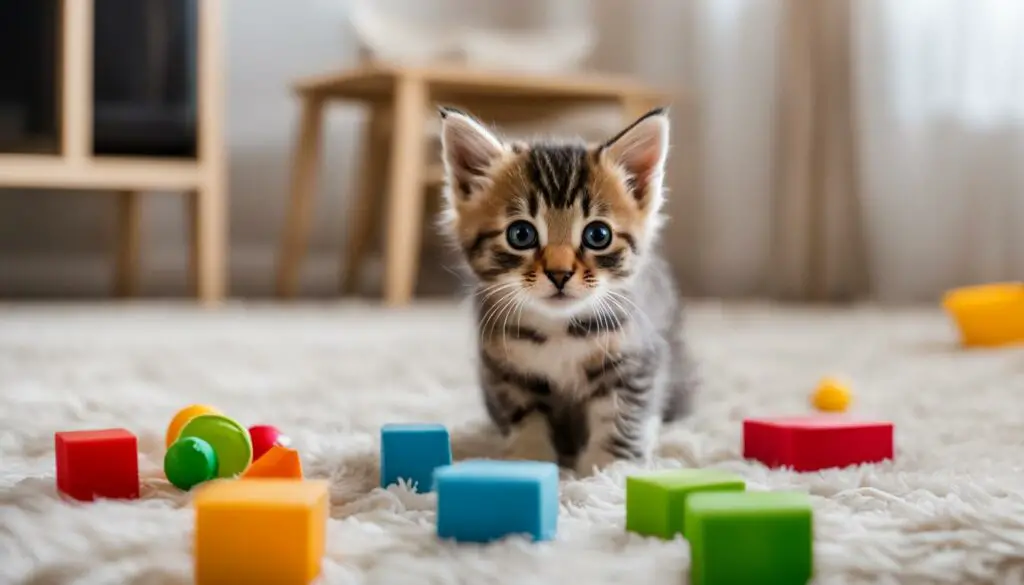
Table 1: Basic Commands for Cats
| Command | Description |
|---|---|
| Gentle | Teaches your cat to be gentle with their claws and play behavior. |
| Find It | Stimulates your cat’s hunting instincts by hiding treats or toys. |
| Target | Trains your cat to touch an object with their nose or paw. |
| Sit | Teaches your cat to sit on command. |
| On Your Mat | Encourages your cat to go to a designated mat or bed. |
| Come | Ensures your cat responds to your call and returns to you. |
| In the Box or Carrier | Trains your cat to willingly enter a carrier or travel box. |
Positive Reinforcement Training for Cats
I have found that positive reinforcement training is one of the most effective methods of training cats. With this approach, I focus on rewarding my cat for behaviors that I want to encourage, rather than punishing them for unwanted behaviors. This creates a positive and rewarding experience for both me and my feline friend.
Using treats and a clicker as auditory markers, I am able to clearly communicate with my cat and reinforce desired behaviors. For example, when my cat sits on command or uses their scratching post instead of the furniture, I immediately reward them with a treat and a click. This helps them understand that they are doing something right and encourages them to repeat the behavior.
“Positive reinforcement training is simple and effective. Reward your cat immediately when they do something you like, and use a clicker or auditory marker to mark the desired behavior.”
Consistency is key when it comes to positive reinforcement training. I make sure to reward my cat every time they perform the desired behavior, so they associate that behavior with a positive outcome. I also keep training sessions short and end them with a fun activity, like playtime or a favorite toy, to keep my cat engaged and motivated.
Overall, positive reinforcement training is a gentle and rewarding approach to training cats. It strengthens the bond between me and my cat, promotes good behavior, and helps prevent any behavior issues that may arise. By using this method, I have been able to teach my cat various tricks and commands while keeping training sessions enjoyable and stress-free for both of us.
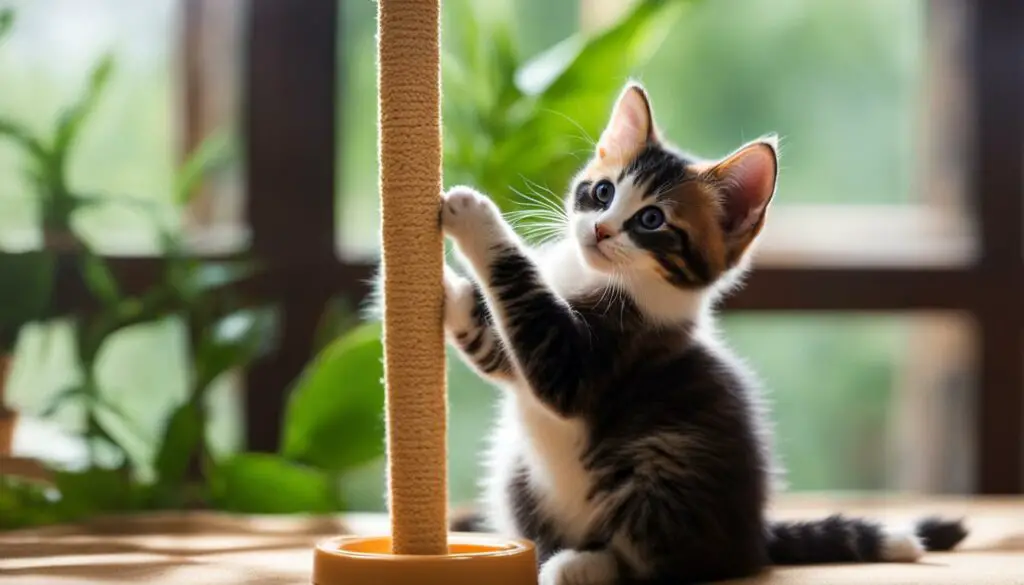
Why Training Your Cat is Important
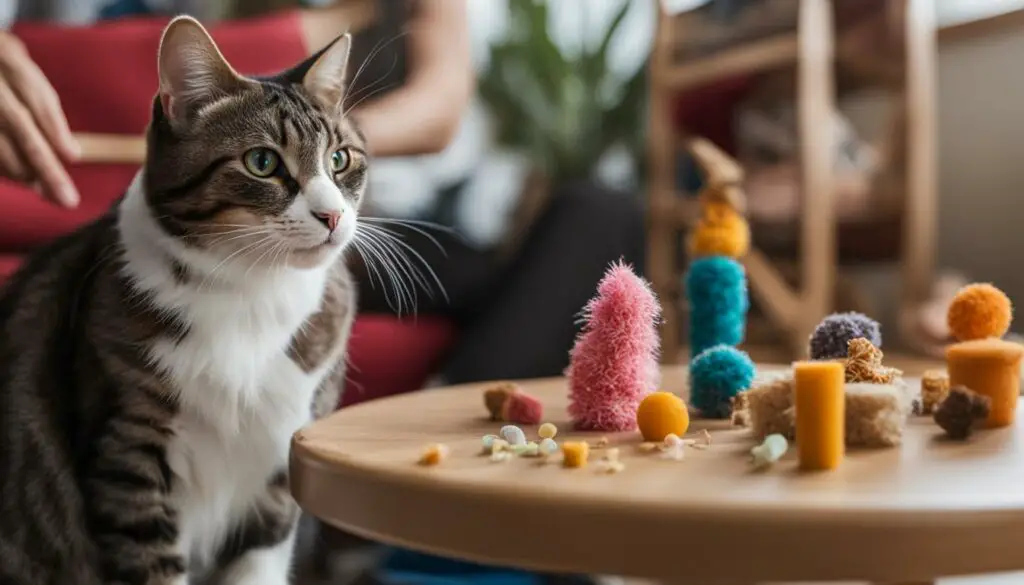
Training your cat is not only important for creating a well-behaved pet, but it also provides essential mental stimulation. Cats are intelligent animals, and without proper mental engagement, they can become bored, frustrated, and develop behavioral problems. By training your cat, you can offer them the mental challenge they need to stay happy and fulfilled.
One of the key reasons why training is important for cats is that it helps prevent behavior problems. Cats that are not trained may exhibit destructive behaviors like scratching furniture, biting, or urinating outside the litter box. These behaviors can be frustrating for both you and your cat, but by providing appropriate training, you can redirect their natural instincts and prevent these issues from occurring.
Training also strengthens the bond between you and your cat. Through training sessions, you establish positive social interaction and build trust. Cats learn to associate you with rewards and positive experiences, which deepens the connection between you. It’s a great way to enhance your relationship and create a harmonious living environment.
The Importance of Mental Stimulation for Cats
Cats need mental stimulation just as much as they need physical exercise. Lack of mental stimulation can lead to boredom, lethargy, and even depression in cats. Training provides the mental challenge and enrichment that cats crave. It engages their problem-solving skills, helps them develop new behaviors, and keeps their minds active and alert.
By incorporating training into your cat’s routine, you provide them with opportunities to learn and explore. Training sessions can be fun for both you and your cat, and it allows you to tap into their natural instincts. Whether it’s teaching them to sit, crawl through a tunnel, or play with puzzle toys, training keeps their minds sharp and prevents boredom-related behavior problems.
In conclusion, training your cat is vital for their overall well-being. It offers mental stimulation, prevents behavior problems, and strengthens the bond between you and your furry friend. So, grab some treats, a clicker, and start training your cat today!
Creating a Cat-Friendly Outdoor Space
As an avid cat lover, I understand the importance of providing a safe and inviting outdoor space for our feline friends. Whether you have a beloved pet cat or want to attract stray cats to a specific area, creating a cat-friendly outdoor space is essential. This not only benefits the cats but also enhances our own connection with these beautiful creatures.
To attract stray cats to your outdoor space, it’s crucial to provide the necessities they require. Start by setting up feeding stations where you can provide food and water on a regular basis. Consider using automatic feeders to ensure a consistent schedule, as this will help build trust with the cats and encourage them to return.
Another important aspect is providing outdoor cat shelters. These shelters offer a safe and comfortable place for cats to rest and seek refuge from the elements. You can choose from a variety of pre-made options or even create your own DIY shelters. Insulating them with straw and providing bedding will ensure warmth during colder months.
| Outdoor Cat Space Essentials | Benefits |
|---|---|
| Feeding Stations | Attracts cats and builds trust |
| Cat Shelters | Provides a safe and comfortable resting place |
| Outdoor Litter Box | Encourages cats to use a designated elimination area |
| Cat-Friendly Elements | Creates an engaging and stimulating environment |
To make the space more appealing, consider adding cat-friendly elements such as scratching posts, play areas, and catnip plants. These features will provide stimulation and entertainment for the cats, enhancing their overall well-being. Additionally, incorporating natural elements like pinecones and grasses will mimic their natural environment and further enrich their outdoor experience.
Lastly, it’s crucial to implement a TNR (trap-neuter-return) program for stray cats in the area. This program helps control the cat population, ensuring their health and well-being while preventing unwanted behaviors such as spraying or fighting. By spaying or neutering the cats, you contribute to a more harmonious coexistence between humans and felines.
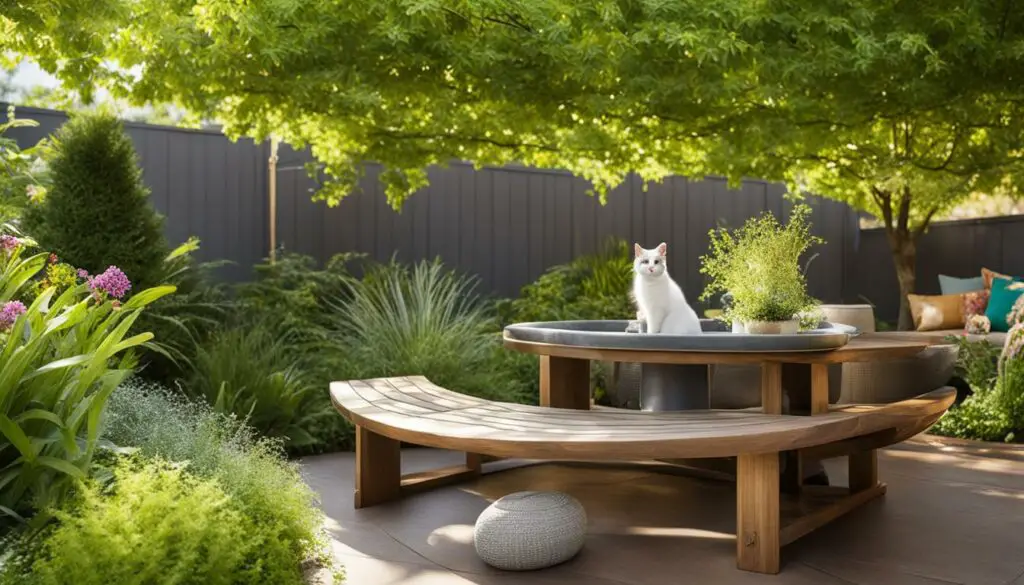
Creating a cat-friendly outdoor space is not only beneficial for the cats themselves but also contributes to a sense of community and environmental conservation. By providing shelter, food, and a safe environment, we can attract stray cats to a specific area and create a bond between humans and felines. Let’s embrace the beauty of outdoor spaces that cater to our beloved cats and build a world where they thrive.
Building Outdoor Cat Shelters
When creating an outdoor space for community cats, providing shelters is crucial to ensure their comfort and safety. There are various options available for building cat shelters, depending on your preference and resources. Here are some cat shelter options to consider:
1. Pre-Made Shelters
Pre-made cat shelters are a convenient option that requires minimal construction. These shelters often come in different sizes and designs, providing insulation and protection against the elements. They are typically made of durable materials such as plastic or wood, ensuring longevity.
2. DIY Shelters
Building your own cat shelters allows for customization and creativity. You can repurpose materials such as storage containers, wooden crates, or even insulated coolers. When constructing a DIY shelter, it’s important to ensure proper insulation to keep the cats warm during colder months. Adding straw as bedding can provide additional insulation.
3. Insulated Shelters
Insulated cat shelters are designed to provide optimal warmth in colder climates. These shelters often have double walls with insulation in between, helping to retain heat. Insulated shelters can be purchased or constructed using materials such as foam insulation boards or styrofoam coolers.
Remember, regardless of the type of shelter you choose, it’s essential to regularly clean and maintain them to ensure a hygienic and comfortable environment for the cats.
| Shelter Type | Pros | Cons |
|---|---|---|
| Pre-Made Shelters | Convenient and easy to set up | May be more expensive than DIY options |
| DIY Shelters | Customizable and cost-effective | Requires more time and effort for construction |
| Insulated Shelters | Provides optimal warmth in colder climates | May require additional insulation materials |
Building outdoor cat shelters is an essential part of creating a cat-friendly outdoor space. By providing comfortable and insulated shelters, you can ensure that community cats have a safe refuge from the elements, contributing to their overall well-being.
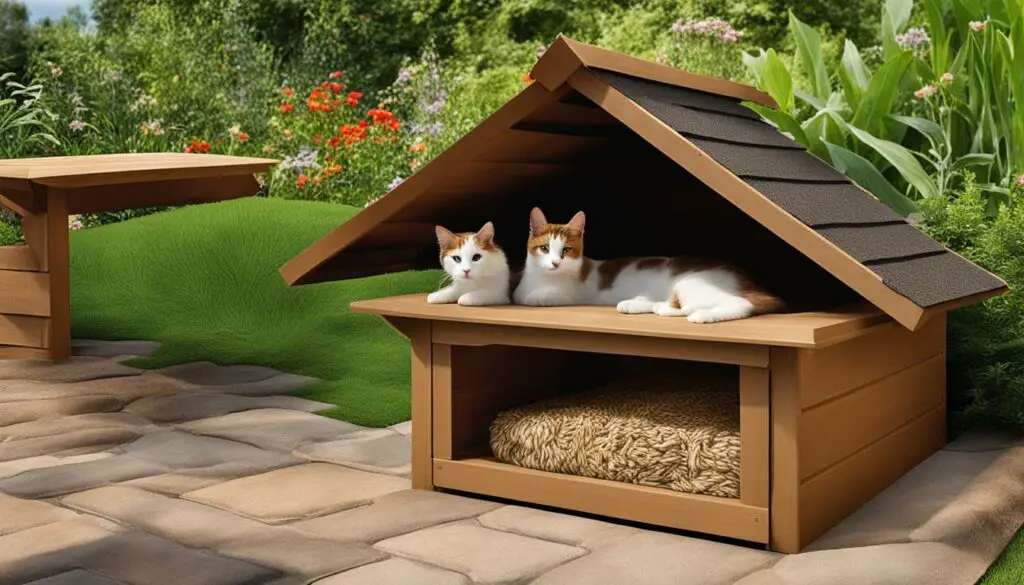
Feeding Community Cats
Feeding community cats on a regular schedule is crucial in attracting them to a specific area. By establishing outdoor feeding stations, you provide a reliable source of food, which encourages cats to keep coming back. When setting up these stations, it’s important to consider the location and the type of food you provide.
Outdoor feeding stations should be placed away from foot traffic or loud noises to create a calm and safe environment for the cats. This ensures that they feel comfortable while eating. Additionally, using a feeding station helps keep the food secure from bugs or wildlife, preventing it from being consumed by unintended visitors.
When selecting a cat food, opt for high-quality options that meet their nutritional needs. Look for brands that contain real meat as the first ingredient and avoid artificial additives or preservatives. Regularly replace the water, ensuring it is fresh and clean to keep the cats hydrated and healthy.
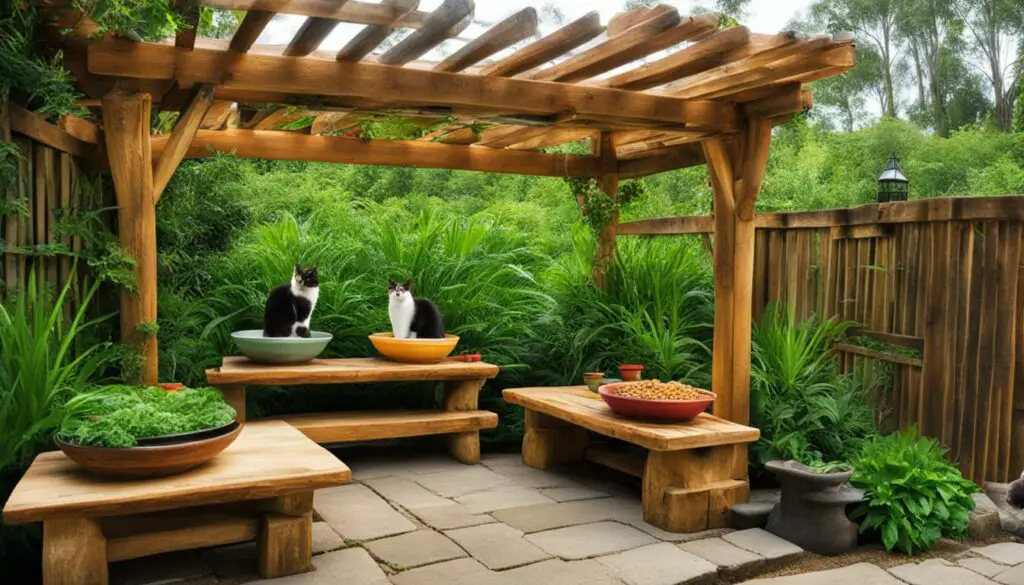
Benefits of Regular Feeding Schedule
Establishing a regular feeding schedule not only helps attract community cats but also provides a sense of routine and security for them. Cats are creatures of habit and thrive on consistency. By feeding them at the same time every day, you create a sense of predictability and trust, allowing them to feel more comfortable in their surroundings.
In addition to attracting cats, a regular feeding schedule also offers an opportunity for caretakers to monitor their health. By observing their eating habits and appearance, you can identify any changes in behavior or potential health issues. This allows for early intervention and timely veterinary care if needed.
Outdoor Feeding Station Recommendations
When setting up an outdoor feeding station, consider using a feeding station specifically designed for cats. These stations are usually elevated, providing a comfortable height for cats to eat without having to crouch down. They also often come with a roof or canopy to protect the food from rain or direct sunlight.
For a more DIY approach, you can create your own feeding station using a sturdy table or platform and a weatherproof container to hold the food. Make sure the container has a secure lid to prevent pests from accessing the food. Place the feeding station in a shaded area to keep the food fresh and inviting for the cats.
| Feeding Station Recommendations: | Benefits: |
|---|---|
| Elevated feeding platforms | Provide comfortable eating position |
| Weatherproof containers | Protect food from rain |
| Secure lids | Prevent pests from accessing food |
| Shaded location | Keep food fresh and inviting |
Providing Water for Community Cats
When creating an outdoor space for community cats, it’s essential to provide them with access to fresh water. Cats need water for hydration, especially in hot weather. Here are some tips for ensuring that community cats have access to clean drinking water:
- Outdoor Water Bowls: Place water bowls near the feeding stations to provide a convenient water source for the cats. Make sure to clean and replenish the water regularly to prevent stagnation or contamination.
- Running Water Feature: Consider adding a running water feature, such as a small pond or fountain, to attract cats. Cats are often attracted to the sound and movement of running water, and it can encourage them to drink more.
Remember, it’s important to ensure that the water is clean and free from contaminants. Regularly check the water bowls or running water feature for debris or algae growth and clean them as needed. By providing access to fresh water, you can help keep community cats hydrated and healthy.
“Water is essential for the well-being of community cats. By providing clean and accessible water sources, we can contribute to their overall health and well-being.”
Next, let’s explore the importance of creating an outdoor litter box for community cats.
| Advantages | Disadvantages |
|---|---|
| Cats can stay hydrated and prevent dehydration. | Water bowls may attract other animals or pests. |
| Running water can help cats stay cool in hot weather. | Regular maintenance is required to keep water clean and free from contaminants. |

Designing an Outdoor Litter Box for Community Cats
When creating an outdoor space for community cats, it’s essential to provide them with a designated area for eliminating waste. Designing an outdoor litter box ensures that the cats have a clean and convenient place to do their business. Here are some key considerations for designing an outdoor litter box for community cats:
Location
Choose a quiet and out-of-the-way location for the litter box, away from their food and sleeping areas. Cats prefer privacy when using the litter box, so find a spot that offers some seclusion. Additionally, ensure that the location allows for easy access and is easily maintainable.
Materials
When creating an outdoor litter box, consider using materials that are durable and easy to clean. Opt for a sturdy box or container that can withstand outdoor elements and won’t easily tip over. Line the box with a thick layer of litter or straw to provide a comfortable surface for the cats to use.
Maintenance
Regular maintenance is crucial to keep the outdoor litter box clean and hygienic. Scoop the litter box daily to remove waste and replenish the litter as needed. Cleaning the litter box regularly helps prevent odors and keeps the area inviting for the cats to use. Consider using natural, biodegradable litter options for sustainability.
| Benefits of an Outdoor Litter Box | Considerations for Design |
|---|---|
| Provides a designated area for cat elimination | Choose a location that offers privacy |
| Helps maintain cleanliness in the outdoor space | Use sturdy and easy-to-clean materials |
| Prevents cats from eliminating in undesirable areas | Maintain the litter box regularly |
| Encourages good hygiene and health for cats | Consider using natural, biodegradable litter |
Having an outdoor litter box in the community cat space not only promotes good hygiene but also helps prevent cats from eliminating in undesirable areas. By providing a clean and accessible space for cat elimination, you are contributing to the overall well-being and comfort of the community cats.
Cat-Friendly Outdoor Spaces: Creating a Haven for Your Feline Friends
Creating an outdoor space that is cat-friendly is a wonderful way to provide enrichment and stimulation for your furry companions. By incorporating elements that cater to their natural instincts, you can ensure that your cats have a safe and enjoyable environment to explore. Here are some ideas for enhancing your outdoor space for cats:
1. Cat Garden:
Planting a cat garden with catnip and other feline-friendly plants is a fantastic way to attract your cats to specific areas of your outdoor space. Catnip, in particular, is known to have a euphoric effect on cats and can provide hours of entertainment as they roll, rub, and play in the herb. Incorporate plants like cat grass, valerian, and silver vine to further stimulate your cats’ senses.
2. Kitty Jungle Gym:
Create a kitty jungle gym by incorporating different surfaces and hiding spots. Install cat trees, scratching posts, and platforms at various heights to encourage climbing and jumping. Add tunnels, boxes, and cat-friendly toys to create an engaging and interactive space. Providing ample opportunities for exercise and play will keep your cats happy and entertained.
3. Resting and Relaxation Areas:
Designate comfortable resting areas where your cats can nap and lounge peacefully. Place cozy beds, hammocks, or blankets in shaded spots to provide a cool and comfortable space for them to relax. Consider adding perches or window shelves near windows, allowing your cats to enjoy the view and bask in the sunlight.
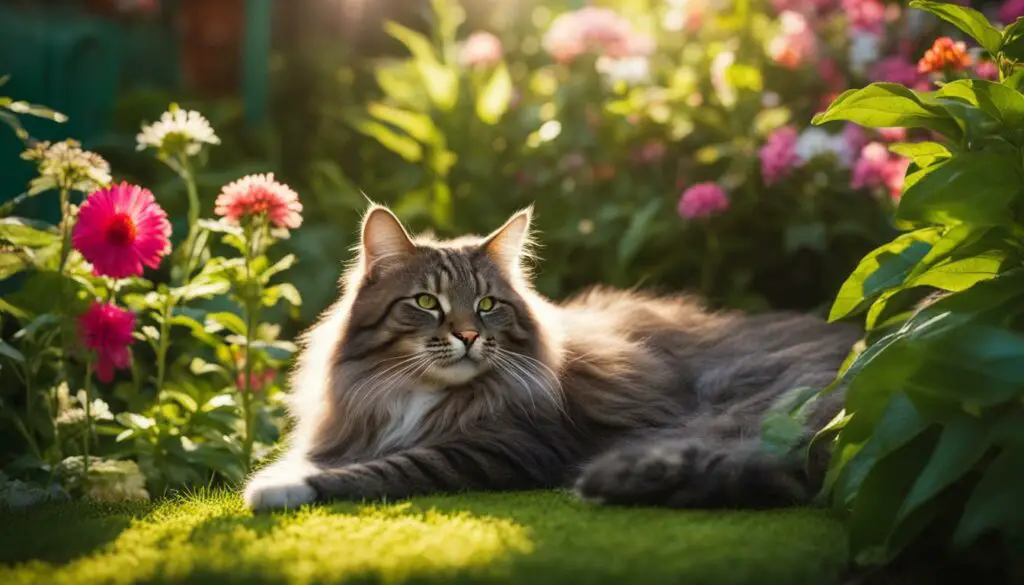
4. Environmental Enrichment:
Introduce natural elements like pinecones, grasses, and rocks to create a sensory-rich environment for your cats. These natural objects can serve as toys and provide mental stimulation. Cats love to explore different textures, scents, and sounds, so incorporating these elements into your outdoor space will keep them engaged and entertained.
Remember to prioritize your cats’ safety by ensuring that your outdoor space is secure and escape-proof. Regularly inspect for any hazards or potential dangers such as toxic plants or gaps in fences. By creating a cat-friendly outdoor space, you are providing your feline friends with the opportunity to engage in their natural behaviors and enjoy the great outdoors.
Maintaining the Outdoor Cat Space
Keeping the outdoor cat space clean and well-maintained is crucial for the health and happiness of community cats. Regular cleaning and refreshing of shelters, feeding stations, water bowls, and litter boxes are essential tasks in outdoor cat care. By following these maintenance practices, you can create a welcoming and safe environment for community cats.
Cleaning Outdoor Cat Space
To ensure a clean outdoor cat space, it’s important to establish a cleaning routine. Regularly clean the feeding stations, water bowls, and litter boxes to remove any food debris or waste. This helps prevent the spread of diseases and keeps the area hygienic for the cats. Use mild, cat-safe cleaning agents and rinse thoroughly to avoid any potential harm.
Additionally, regularly remove any litter or waste from the outdoor area to maintain cleanliness. Clear away any debris or hazardous items that could pose a risk to the cats, such as sharp objects or toxic substances. By keeping the outdoor space clean and free from hazards, you create a safer environment for the cats to roam and explore.
Refreshing Cat Shelters
Outdoor cat shelters provide essential protection from the elements, and they need regular maintenance to keep them comfortable and functional. Every 3 to 6 months, it’s important to refresh the straw inside the shelters. Replace old, soiled straw with fresh straw to provide insulation and a cozy space for the cats. This helps keep them warm during colder months and provides a comfortable resting place.
Inspect the shelters regularly for any damage or wear and tear. Repair or replace any broken parts to ensure the shelters remain sturdy and secure. Regularly check the entrances and exits to remove any blockages that could prevent the cats from accessing the shelter. By maintaining the shelters, you provide a safe and comfortable haven for the community cats in your outdoor space.
| Task | Frequency |
|---|---|
| Cleaning feeding stations, water bowls, and litter boxes | Regularly, at least once a day |
| Removing litter and waste from the outdoor area | Regularly, as needed |
| Refreshing straw in shelters | Every 3 to 6 months |
| Inspecting and repairing shelters | Regularly, as needed |
Maintaining the outdoor cat space requires dedication and regular upkeep. By cleaning the feeding stations, water bowls, and litter boxes, as well as refreshing the cat shelters, you ensure a clean and comfortable environment for the community cats. Regular inspections and repairs protect the cats from potential hazards and contribute to their overall well-being. With proper maintenance, you can create a thriving outdoor space that benefits both the cats and the community.
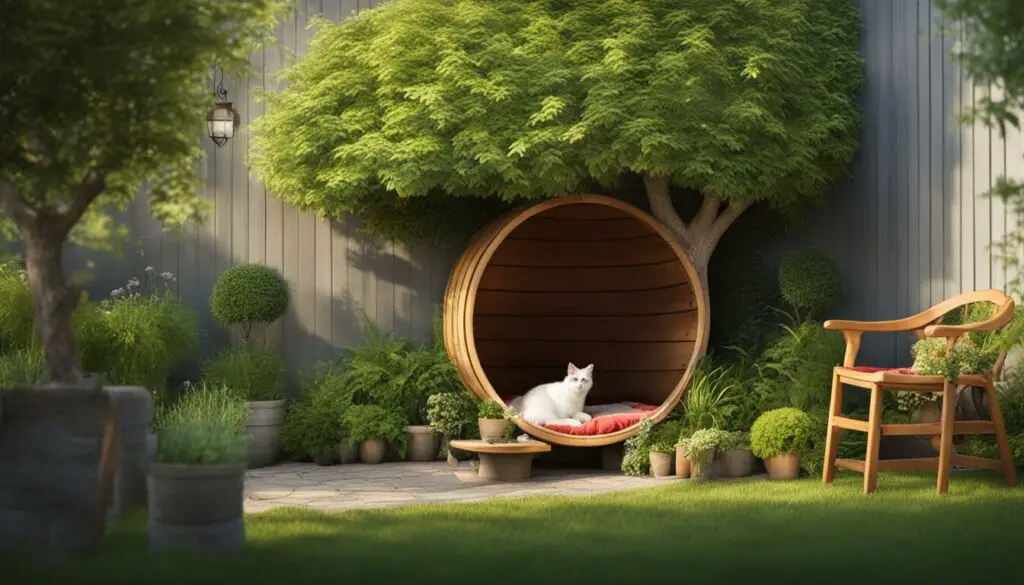
Creating a Cat-Friendly Community
Creating a cat-friendly community goes beyond providing for the needs of community cats. It involves advocating for their well-being and promoting environmental conservation. By taking these steps, we can create a healthy neighborhood that benefits both cats and humans.
Advocating for community cats means raising awareness about their presence and the importance of their care. Educate your neighbors about the benefits of TNR programs and responsible cat ownership. Encourage them to support local initiatives that provide medical care, spaying/neutering, and adoption programs for community cats.
Environmental conservation is another crucial aspect of creating a cat-friendly community. Avoid using harmful chemicals on your property, as they can negatively impact the health of cats and other wildlife. Instead, opt for natural and eco-friendly alternatives. Plant native vegetation to attract birds and beneficial insects, creating a balanced ecosystem that benefits cats and the environment.
“We must remember that cats are part of a larger ecosystem and play an important role in maintaining the balance of nature. By creating cat-friendly communities, we are not only improving the lives of cats but also contributing to the overall health of our environment.” – Cat Advocate
| Benefits of a Cat-Friendly Community | Actions to Take |
|---|---|
| Reduced population of feral cats | Support TNR programs and advocate for spaying/neutering |
| Improved well-being of community cats | Encourage responsible cat ownership and provide resources for cat care |
| Conservation of wildlife | Plant native vegetation and avoid the use of harmful chemicals |
| Enhanced sense of community | Engage with your neighbors and promote cat-friendly initiatives |
By creating a cat-friendly community, we can ensure the well-being of community cats while also fostering a healthier environment for all. Together, we can make a positive impact and create a neighborhood that is truly inclusive and supportive of our feline friends.

Conclusion
In conclusion, attracting cats to a specific space involves understanding their behavior and providing the right environment. Training cats using positive reinforcement techniques can help alleviate boredom, frustration, and destructive behavior. By teaching cats basic commands and words, you can strengthen the bond between you and your feline friend.
Creating a cat-friendly outdoor space for community cats requires setting up feeding stations, shelters, and litter boxes. Customizing the space with cat-friendly plants and play areas enhances their experience. Regular maintenance, including cleaning and refreshing the outdoor cat space, ensures a clean and appealing environment.
Advocating for a cat-friendly community not only benefits community cats but also contributes to a healthy neighborhood. Considering the overall impact on the environment and advocating for environmental conservation is essential. By providing cats with the necessary resources and caring for their well-being, we can create a harmonious community for both humans and feline companions.
FAQ
Can cats be trained like dogs?
Yes, cats can be trained just like dogs. Training provides mental and physical stimulation for them.
What motivates cats during training?
Cats are motivated by rewards, such as treats and positive attention.
What are some basic training commands for cats?
Basic training commands for cats include teaching them not to bite, walk on a leash, and redirecting their predatory instincts to toys.
How should training sessions with cats be structured?
Training sessions with cats should be short and end with a fun activity.
Why is training important for cats?
Training provides positive social contact, helps with boredom and frustration, and prevents destructive behavior.
How can I attract stray cats to a specific outdoor space?
By providing food, water, shelter, and an outdoor litter box. Using a TNR program to spay or neuter the cats can also help.
What options are there for outdoor cat shelters?
There are pre-made options or DIY options for outdoor cat shelters. Insulating the shelters with straw and providing bedding for warmth is important.
How should I feed community cats?
Set up outdoor feeding stations away from foot traffic or loud noises. Use a feeding station to keep the food secure from bugs or wildlife.
Do community cats need access to fresh water?
Yes, placing water bowls near the feeding stations and replacing the water regularly is important.
How can I create an outdoor litter box for community cats?
Choose a quiet and out-of-the-way location for the litter box, away from food or sleeping areas. Use litter or straw to create a designated elimination area for the cats.
How can I enhance the outdoor space for cats?
Planting catnip and other cat-friendly plants, setting up a kitty jungle gym, and providing areas for nap, scratch, and play can enhance the outdoor space for cats.
How should I maintain the outdoor cat space?
Regularly clean the feeding stations, water bowls, and litter boxes. Refresh the straw in shelters every 3 to 6 months. Keep the area tidy and free from hazards.
How can I create a cat-friendly community?
Advocating for the well-being of community cats, promoting environmental conservation, and considering the overall impact on the neighborhood and the planet can help create a cat-friendly community.








